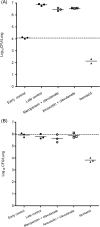In vitro and in vivo efficacy of β-lactams against replicating and slowly growing/nonreplicating Mycobacterium tuberculosis
- PMID: 23507276
- PMCID: PMC3716166
- DOI: 10.1128/AAC.00023-13
In vitro and in vivo efficacy of β-lactams against replicating and slowly growing/nonreplicating Mycobacterium tuberculosis
Abstract
Beta-lactams, in combination with beta-lactamase inhibitors, are reported to have activity against Mycobacterium tuberculosis bacteria growing in broth, as well as inside the human macrophage. We tested representative beta-lactams belonging to 3 different classes for activity against replicating M. tuberculosis in broth and nonreplicating M. tuberculosis under hypoxia, as well as against streptomycin-starved M. tuberculosis strain 18b (ss18b) in the presence or absence of clavulanate. Most of the combinations showed bactericidal activity against replicating M. tuberculosis, with up to 200-fold improvement in potency in the presence of clavulanate. None of the combinations, including those containing meropenem, imipenem, and faropenem, killed M. tuberculosis under hypoxia. However, faropenem- and meropenem-containing combinations killed strain ss18b moderately. We tested the bactericidal activities of meropenem-clavulanate and amoxicillin-clavulanate combinations in the acute and chronic aerosol infection models of tuberculosis in BALB/c mice. Based on pharmacokinetic/pharmacodynamic indexes reported for beta-lactams against other bacterial pathogens, a cumulative percentage of a 24-h period that the drug concentration exceeds the MIC under steady-state pharmacokinetic conditions (%TMIC) of 20 to 40% was achieved in mice using a suitable dosing regimen. Both combinations showed marginal reduction in lung CFU compared to the late controls in the acute model, whereas both were inactive in the chronic model.
Figures



Similar articles
-
Is there a place for β-lactams in the treatment of multidrug-resistant/extensively drug-resistant tuberculosis? Synergy between meropenem and amoxicillin/clavulanate.J Antimicrob Chemother. 2013 Feb;68(2):366-9. doi: 10.1093/jac/dks395. Epub 2012 Oct 15. J Antimicrob Chemother. 2013. PMID: 23070734
-
In Vitro Activity of β-Lactams in Combination with β-Lactamase Inhibitors against Multidrug-Resistant Mycobacterium tuberculosis Isolates.Antimicrob Agents Chemother. 2015 Nov 2;60(1):393-9. doi: 10.1128/AAC.01035-15. Print 2016 Jan. Antimicrob Agents Chemother. 2015. PMID: 26525785 Free PMC article.
-
Activity of faropenem with and without rifampicin against Mycobacterium tuberculosis: evaluation in a whole-blood bactericidal activity trial.J Antimicrob Chemother. 2017 Jul 1;72(7):2012-2019. doi: 10.1093/jac/dkx081. J Antimicrob Chemother. 2017. PMID: 28333342 Clinical Trial.
-
Mechanisms of β-lactam killing and resistance in the context of Mycobacterium tuberculosis.J Antibiot (Tokyo). 2014 Sep;67(9):645-54. doi: 10.1038/ja.2014.94. Epub 2014 Jul 23. J Antibiot (Tokyo). 2014. PMID: 25052484 Review.
-
Imipenem-Relebactam and Meropenem-Vaborbactam: Two Novel Carbapenem-β-Lactamase Inhibitor Combinations.Drugs. 2018 Jan;78(1):65-98. doi: 10.1007/s40265-017-0851-9. Drugs. 2018. PMID: 29230684 Review.
Cited by
-
Have we realized the full potential of β-lactams for treating drug-resistant TB?IUBMB Life. 2018 Sep;70(9):881-888. doi: 10.1002/iub.1875. Epub 2018 Jun 22. IUBMB Life. 2018. PMID: 29934998 Free PMC article. Review.
-
Susceptibilities of MDR Mycobacterium tuberculosis isolates to unconventional drugs compared with their reported pharmacokinetic/pharmacodynamic parameters.J Antimicrob Chemother. 2017 Jun 1;72(6):1678-1687. doi: 10.1093/jac/dkx022. J Antimicrob Chemother. 2017. PMID: 28333192 Free PMC article.
-
Identification of Mycobacterial Genes Involved in Antibiotic Sensitivity: Implications for the Treatment of Tuberculosis with β-Lactam-Containing Regimens.Antimicrob Agents Chemother. 2017 Jun 27;61(7):e00425-17. doi: 10.1128/AAC.00425-17. Print 2017 Jul. Antimicrob Agents Chemother. 2017. PMID: 28438925 Free PMC article.
-
CRISPRi-mediated characterization of novel anti-tuberculosis targets: Mycobacterial peptidoglycan modifications promote beta-lactam resistance and intracellular survival.Front Cell Infect Microbiol. 2023 Mar 15;13:1089911. doi: 10.3389/fcimb.2023.1089911. eCollection 2023. Front Cell Infect Microbiol. 2023. PMID: 37009497 Free PMC article.
-
Ethambutol and meropenem/clavulanate synergy promotes enhanced extracellular and intracellular killing of Mycobacterium tuberculosis.Antimicrob Agents Chemother. 2024 Apr 3;68(4):e0158623. doi: 10.1128/aac.01586-23. Epub 2024 Feb 27. Antimicrob Agents Chemother. 2024. PMID: 38411952 Free PMC article.
References
-
- Zhanel GG, Wiebe R, Dilay L, Thomson K, Rubinstein E, Hoban DJ, Noreddin AM, Karlowsky JA. 2007. Comparative review of the carbapenems. Drugs 67:1027–1052 - PubMed
-
- Nampoothiri KM, Rubex R, Patel AK, Narayanan SS, Krishna S, Das SM, Pandey A. 2008. Molecular cloning, overexpression and biochemical characterization of hypothetical beta-lactamases of Mycobacterium tuberculosis H37Rv. J. Appl. Microbiol. 105:59–67 - PubMed
-
- Tremblay LW, Hugonnet JE, Blanchard JS. 2008. Structure of the covalent adduct formed between Mycobacterium tuberculosis beta-lactamase and clavulanate. Biochemistry 47:5312–5316 - PubMed
-
- Harrison MP, Moss SR, Featherstone A, Fowkes AG, Sanders AM, Case DE. 1989. The disposition and metabolism of meropenem in laboratory animals and man. J. Antimicrob. Chemother. 24(Suppl. A):265–277 - PubMed
MeSH terms
Substances
LinkOut - more resources
Full Text Sources
Other Literature Sources
Medical

